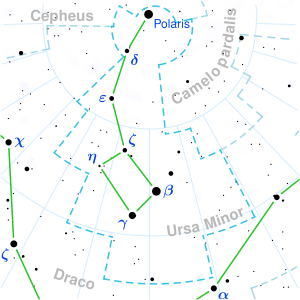WISE 1506+7027
Location of WISE 1506+7027 in the constellation Ursa Minor | |
| Observation data Epoch J2000 Equinox J2000 | |
|---|---|
| Constellation | Ursa Minor |
| Right ascension | 15h 06m 52.4403s[1] |
| Declination | 70° 27′ 25.1182″[1] |
| Characteristics | |
| Spectral type | T6[2][3] |
| Apparent magnitude (J (2MASS filter system)) | 14.328±0.095[2] |
| Apparent magnitude (J (MKO filter system)) | 13.56±0.05[2] |
| Apparent magnitude (H (2MASS filter system)) | 14.150±0.203[2] |
| Apparent magnitude (H (MKO filter system)) | 13.91±0.04[2] |
| Apparent magnitude (KS (2MASS filter system)) | 14.048±0.136[2] |
| Astrometry | |
| Proper motion (μ) | RA: −1,194.085[1] mas/yr Dec.: 1,044.300[1] mas/yr |
| Parallax (π) | 193.5 ± 0.6 mas[4] |
| Distance | 16.86 ± 0.05 ly (5.17 ± 0.02 pc) |
| Other designations | |
| Database references | |
| SIMBAD | data |
WISEPC J150649.97+702736.0 (designation abbreviated to WISE 1506+7027, or WISE J1506+7027) is a brown dwarf star of spectral class T6,[2][3] located in constellation Ursa Minor.[note 1] It is one of the Sun's nearest neighbors, at a distance of 16.85 light-years.[1] Brown dwarfs closer to the Sun include Luhman 16, WISE 0855−0714, ε Indi Ba and ε Indi Bb.
Discovery
[edit]
WISE 1506+7027 was discovered in 2011 from data collected by the Wide-field Infrared Survey Explorer (WISE) in the infrared at a wavelength of 40 cm (16 in), whose mission lasted from December 2009 to February 2011. In 2011, Kirkpatrick and colleagues published a paper in The Astrophysical Journal Supplement, where they presented discovery of 98 new found by WISE brown dwarf systems with components of spectral types M, L, T and Y, among which also was WISE 1506+7027.[2][note 2]
Distance
[edit]The first trigonometric parallax of WISE 1506+7027, which was published in 2013 by Marsh et al., is 0.310″±0.042″, corresponding to a distance 3.4+0.7
−0.4 pc, or 11.1+2.3
−1.3 ly.[5] The Gaia spacecraft determined an updated parallax of 193.5 milliarcseconds leading to a distance of 16.85 light years.[1]
Space motion
[edit]WISE 1506+7027 has a large proper motion of about 1,623 milliarcseconds per year.[5]
Notes
[edit]- ^ The nearest known star/brown dwarf in this constellation.
- ^ These 98 brown dwarf systems are only among first, not all brown dwarf systems, discovered from data, collected by WISE: six discoveries were published earlier (however, also listed in Kirkpatrick et al. (2011)), in Mainzer et al. (2011), and Burgasser et al. (2011), and the other discoveries were published later.
References
[edit]- ^ a b c d e f Brown, A. G. A.; et al. (Gaia collaboration) (August 2018). "Gaia Data Release 2: Summary of the contents and survey properties". Astronomy & Astrophysics. 616. A1. arXiv:1804.09365. Bibcode:2018A&A...616A...1G. doi:10.1051/0004-6361/201833051. Gaia DR2 record for this source at VizieR.
- ^ a b c d e f g h i j k Kirkpatrick, J. Davy; Cushing, Michael C.; Gelino, Christopher R.; Griffith, Roger L.; Skrutskie, Michael F.; Marsh, Kenneth A.; Wright, Edward L.; Mainzer, Amy K.; Eisenhardt, Peter R.; McLean, Ian S.; Thompson, Maggie A.; Bauer, James M.; Benford, Dominic J.; Bridge, Carrie R.; Lake, Sean E.; Petty, Sara M.; Stanford, Spencer Adam; Tsai, Chao-Wei; Bailey, Vanessa; Beichman, Charles A.; Bloom, Joshua S.; Bochanski, John J.; Burgasser, Adam J.; Capak, Peter L.; Cruz, Kelle L.; Hinz, Philip M.; Kartaltepe, Jeyhan S.; Knox, Russell P.; Manohar, Swarnima; Masters, Daniel; Morales-Calderon, Maria; Prato, Lisa A.; Rodigas, Timothy J.; Salvato, Mara; Schurr, Steven D.; Scoville, Nicholas Z.; Simcoe, Robert A.; Stapelfeldt, Karl R.; Stern, Daniel; Stock, Nathan D.; Vacca, William D. (2011). "The First Hundred Brown Dwarfs Discovered by the Wide-field Infrared Survey Explorer (WISE)". The Astrophysical Journal Supplement. 197 (2): 19. arXiv:1108.4677v1. Bibcode:2011ApJS..197...19K. doi:10.1088/0067-0049/197/2/19. S2CID 16850733.
- ^ a b Kirkpatrick, J. Davy; Gelino, Christopher R.; Cushing, Michael C.; Mace, Gregory N.; Griffith, Roger L.; Skrutskie, Michael F.; Marsh, Kenneth A.; Wright, Edward L.; Eisenhardt, Peter R.; McLean, Ian S.; Mainzer, Amy K.; Burgasser, Adam J.; Tinney, Chris G.; Parker, Stephen; Salter, Graeme (2012). "Further Defining Spectral Type "Y" and Exploring the Low-mass End of the Field Brown Dwarf Mass Function". The Astrophysical Journal. 753 (2). 156. arXiv:1205.2122. Bibcode:2012ApJ...753..156K. doi:10.1088/0004-637X/753/2/156. S2CID 119279752.
- ^ Kirkpatrick, J. Davy; Martin, Emily C.; Smart, Richard L.; Cayago, Alfred J.; Beichman, Charles A.; Marocco, Federico; et al. (February 2019). "Preliminary Trigonometric Parallaxes of 184 Late-T and Y Dwarfs and an Analysis of the Field Substellar Mass Function into the "Planetary" Mass Regime". The Astrophysical Journal Supplement Series. 240 (2): 69. arXiv:1812.01208. Bibcode:2019ApJS..240...19K. doi:10.3847/1538-4365/aaf6af. 19.
- ^ a b Marsh, Kenneth A.; Wright, Edward L.; Kirkpatrick, J. Davy; Gelino, Christopher R.; Cushing, Michael C.; Griffith, Roger L.; Skrutskie, Michael F.; Eisenhardt, Peter R. (2013). "Parallaxes and Proper Motions of Ultracool Brown Dwarfs of Spectral Types Y and Late T". The Astrophysical Journal. 762 (2): 119. arXiv:1211.6977. Bibcode:2013ApJ...762..119M. doi:10.1088/0004-637X/762/2/119. S2CID 42923100.

